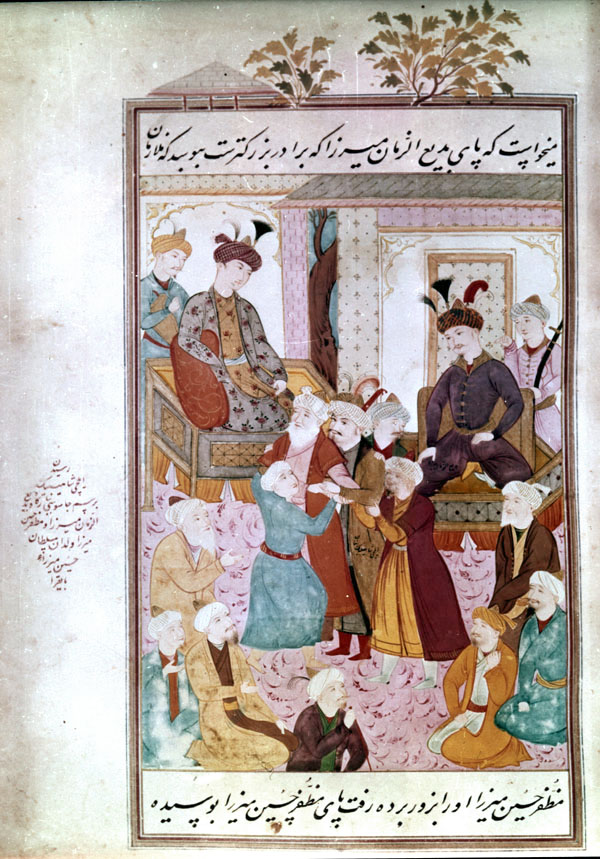Manuscripts
tāriḵ-e ʿālām-ārā-ye šāh esmāʿil
Sultan Hoseyn Mirzā Bāyqarā, the last Timurid ruler of Herat, had three sons, Badiʿ al-Zamān Mirzā, Moẓaffar Ḥoseyn Mirzā, and Köpek Mirzā, who after the death of their father in 1505, had pretensions to independent rule. Upon hearing of the dissension and disagreement between the Timurid princes, Šāhibeg Ḵān (Moḥammad Ḵān Šibāni, the Uzbeg) laid covetous eyes on Khorasan. In 913/1507 Šāhibeg invaded Khorasan, gave battle to the sons of Sultan Ḥoseyn, defeated them, and put them to death. In short, he destroyed the last remnants of the Timurid dynasty and annexed their territory.
The painting illustrates an example of the petty bickering between two of the sons of Sultan Ḥoseyn, who are totally oblivious of the presence before them of an external force that is about to destroy them. The text states that the spy from Šāhibeg wanted to kiss the feet of Badiʿ, the eldest son, but the retainers of the younger son Moẓaffar forced him to kiss his feet instead. Badiʿ al-Zamān Mirzā, in a purple robe and variegated turban, sits cross-legged on a slightly elevated hexagonal throne in the upper right. On the left, also on a slightly elevated throne but of square dimensions, sits his brother Moẓaffar, in a grayish robe with red flowers and a similar colored turban. He leans on a vermillion pillow decorated with gold. In the center of the composition is a tightly compacted group consisting of four retainers of varying sizes and ages, who usher the ambassador of Šāhibeg Ḵān, sandwiched between them, in the direction of Moẓaffar Ḥoseyn. Three seated dignitaries in the lower corners, symmetrically disposed on the vertical central axis, observe the event. Another observer with a walking stick is visible at the bottom, his lower extremities cropped by the frame.

Two attendants, one behind each of the princes, complete the ensemble. One holds a sword, the other a quiver case. The backdrop is a white walled pavilion decorated with gray and pale mauve tiles, gold multilobe arches, and a framed panel. The floor is light rose-mauve sprinkled with red arabesque-like decorations. For the most part, the clothing is executed in dark or intense colors - purple, vermillion, orange, blue, brown - causing the figures to stand out against the light pastel background.
Painting: 24.1 x 13.0 cm. One line of text above and below the painting. Frame encloses painting and text; two branches of a tree and a pyramidal shaped cupola protrude beyond the frame into the top margin. Some of the paint, particularly the blue clothing, has flaked off, exposing the paper underneath. No other signs of damage or retouching. A marginal inscription in red, presumably of later date, describes the event depicted. Inscription in black appear on two of the figures, identify them as Badiʿ al-Zamān Mirzā and the ambassador of Šāhibeg Ḵān.
Painting references:
Mahboubian_1972, #923 folio 165 (not ill.).
Text X-references:
See Muntaẓer-Ṣāḥeb_1970, p.293 for this event in the History of Shah Esmāʿil.
See Savory, SA_1979, p.53 for this event in the History of Shah ʿĀbbās.
Robert Eng
Last Updated: December 9, 2010
Originally published: April 4, 2002